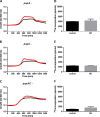Host stress hormone norepinephrine stimulates pneumococcal growth, biofilm formation and virulence gene expression
- PMID: 24996423
- PMCID: PMC4105557
- DOI: 10.1186/1471-2180-14-180
Host stress hormone norepinephrine stimulates pneumococcal growth, biofilm formation and virulence gene expression
Abstract
Background: Host signals are being shown to have a major impact on the bacterial phenotype. One of them is the endogenously produced catecholamine stress hormones, which are also used therapeutically as inotropes. Recent work form our laboratories have found that stress hormones can markedly increase bacterial growth and virulence. This report reveals that Streptococcus pneumoniae, a commensal that can also be a major cause of community acquired and nosocomial pneumonia, is highly inotrope responsive. Therapeutic levels of the stress hormone norepinephrine increased pneumococcal growth via a mechanism involving provision of iron from serum-transferrin and inotrope uptake, as well as enhancing expression of key genes in central metabolism and virulence. Collectively, our data suggests that Streptococcus pneumoniae recognises host stress as an environmental cue to initiate growth and pathogenic processes.
Results: Effects of a clinically attainable concentration of norepinephrine on S. pneumoniae pathogenicity were explored using in vitro growth and virulence assays, and RT-PCR gene expression profiling of genes involved in metabolism and virulence.We found that norepinephrine was a potent stimulator of growth, via a mechanism involving norepinephrine-delivery of transferrin-iron and internalisation of the inotrope. Stress hormone exposure also markedly increased biofilm formation. Importantly, gene profiling showed that norepinephrine significantly enhanced expression of genes involved in central metabolism and host colonisation. Analysis of the response of the pneumococcal pspA and pspC mutants to the stress hormone showed them to have a central involvement in the catecholamine response mechanism.
Conclusions: Collectively, our evidence suggests that the pneumococcus has mechanisms to recognise and process host stress hormones to augment its virulence properties. The ability to respond to host stress signals may be important for the pneumococcal transition from colonization to invasion mode, which is key to its capacity to cause life-threatening pneumonia, septicaemia and meningitis.
Figures




References
-
- Bogaert D, De Groot R, Hermans PW. Streptococcus pneumoniae colonisation: the key to pneumococcal disease. Lancet Infect Dis. 2004;4:144–154. - PubMed
-
- Freestone PP, Sandrini SM, Haigh RD, Lyte M. Microbial endocrinology: how stress influences susceptibility to infection. Trends Microbiol. 2008;16:55–64. - PubMed
-
- Reiche EM, Morimoto HK, Nunes SM. Stress and depression-induced immune dysfunction: implications for the development and progression of cancer. Int Rev Psychiatry. 2005;17:515–527. - PubMed
-
- Sharaff F, Freestone P. Microbial endocrinology. Cent Eur J Biol. 2011;6:685–694.
Publication types
MeSH terms
Substances
LinkOut - more resources
Full Text Sources
Other Literature Sources

